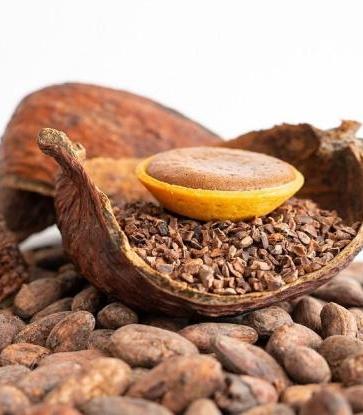For many cultures all over the world, the Easter celebration would not be complete without a homemade loaf, rich with symbolism and special ingredients. Other than the more well-known hot cross buns, other traditional Easter bakes include spiced bread twists and fruit loaves. For Konstantino Blokbergen, founder of Firebake - Woodfired Bakehouse & Restaurant in Singapore, Easter is inextricably linked to the smell of freshly-baked tsoureki.

The baker was born on the Greek island of Corfu, which is known by most Greeks for being one of the nicest places to visit during the Easter holiday, with its myriad of festive activities and culinary traditions that have been around for centuries.
“My family and I used to spend Easter holidays in Corfu on a regular basis during my childhood, so the smell of freshly baked tsoureki is something I cannot forget when walking around the streets of town in the early morning,” he says. “There is a cookie version of these as well; they usually don't last long if I'm around.”
Greek tsoureki is a popular brioche-like bread baked especially during festive celebrations like Christmas and New Year. This traditional braided loaf has a chewiness not unlike bagels. “The main trick for a successful result is to knead the dough really well, allowing the gluten in the flour to develop well until the dough reaches a good elasticity,” adds Konstantino.

Another distinctive trait of tsoureki is its fruity, almond fragrance which comes from an aromatic spice called mahleb (or mahlab, or mastic) which is made from the seeds of a species of cherry. If you have any trouble sourcing the mahleb, Konstantino shares his trick for replicating the taste by carefully mixing almond concentrate and ground star anise.
The tsoureki keeps well over a few days, and in fact tastes even better after two or three days. Simply store in plastic wrap or a container, and enjoy with a nice Greek coffee.

Easter Sourdough Tsoureki
Makes 3 loaves (approx. 400 grams each)Time
Mixing: 15 minutes
Bulk fermentation: 1 hour 30 minutes
Proofing: 4 hours
Baking: 30 to 40 minutes
For the colored eggs:
3 eggs
50 grams vinegar
10 grams water
Few drops of red coloring
Olive oil, for sprinkling
1. Boil the eggs for about 10 minutes till they are hard-boiled; transfer to wire rack.
2. In a small bowl, mix the vinegar, water and red coloring.
3. Wearing a rubber glove, coat each egg in the colored solution, and leave to dry on a cooling rack for few minutes before repeating the coloring process a second time to deepen the color. Let fully dry for 15 minutes.
4. Sprinkle olive oil onto a piece of kitchen paper and rub each egg with it until shiny; reserve.
For the dough:
150 grams stiff starter (white flour sourdough)
300 grams water
2 eggs
1 orange, zested
150 grams wild honey
50 grams unsalted butter, melted
20 grams caster sugar
15 to 20 grams mahleb
10 grams vanilla extract
5 grams ground cardamom
500 grams bread flour, plus more for dusting
12 grams sea salt
100 grams unsalted butter, at room temperature
Egg white, for brushing
Shredded almonds, for garnishing
Method
1. In a stand mixer fitted with a paddle attachment at low speed, dissolve the stiff white sourdough in the water for about 1 minute. Add the eggs, orange zest, honey, melted butter, sugar, mahleb, ground cardamom, and vanilla extract and continue to mix at medium speed for about 3 minutes. Add the flour in 3 batches and continue to mix at medium speed for about 5 minutes.
2. At the end of mixing, add sea salt to strengthen the gluten in the dough.
3. Replace the paddle attachment with a dough hook. Add the soft butter and beat at medium-high speed for about 5 minutes. Stop the mixer and scrape the bowl to make sure all the butter is full incorporated. Finish mixing for at most 3 minutes more.
4. At the end of beating, the dough should be a bit sticky and batter-like. Do a ‘windowpane test’ by pinching off a ball of dough, flattening it and holding it between your thumb and first two fingers. When you slowly spread the dough apart, it should stretch without tearing, forming a thin membrane.
5. Transfer the dough from the mixing bowl onto well-floured kitchen bench. Gently finish the kneading by hand and shape the dough into one large ball.
6. Place the dough in well-buttered bowl, coat in butter to prevent drying and cover with kitchen towel to rest.
7. After the first 30 minutes of bulk fermentation, stretch and fold the dough before covering with a kitchen towel and let rest again. Place in a cool area and let bulk fermentation continue for another 60 minutes.
8. Transfer the dough onto a well-floured kitchen bench, roughly roll the dough and stretch it into a long stick shape. Fold in half, and repeat the same process about 10 times. You may sprinkle some flour to help this stretching process to keep the dough from sticking to the bench. You want to make sure you get the elasticity which will get you the desired chewiness of the tsoureki crumb.
9. Divide the dough into 4 pieces, shaping each one into a long stick (like a baguette), and braid the bread using a 4-strand braiding technique.
10. Once you have achieved one braided loaf, cut it into 3 equal loaves; tidy up the edges of each loaf by tucking them underneath.
11. Transfer all 3 loaves onto a baking tray lined with parchment paper.
12. Place a colored egg in each loaf by pushing it into the dough until it is almost half covered. Brush each loaf with egg white wash and sprinkle with some almonds. Let proof for another 45 to 60 minutes.
13. Bake for about 25 to 30 minutes in a preheated 375˚F oven.
14. Remove from the oven; leave to cool on a wire rack.










